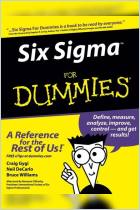Join getAbstract to access the summary!

Join getAbstract to access the summary!
George Eckes
The Six Sigma Revolution
How General Electric and Others Turned Process Into Profits
Wiley, 2000
What's inside?
Six Sigma says define the problem, involve management, change your culture and measure everything. Revolutionary, huh?
Recommendation
George Eckes’ experience in quality control includes an instance where he had the temerity, just out of college, to ask W. Edwards Deming, then an octogenarian, to elaborate on his views about quality. "Those are the most stupid questions I have ever heard! Go read some of my books," the cantankerous quality czar responded. No one reading this volume can doubt that Eckes has done his homework ever since. His blend of experience, theoretical expertise and common sense make this a very effective Six Sigma manual, although it is a little light on case studies. One of the book’s most valuable elements is Eckes’ keen analysis of the pitfalls that can flush all your best Six Sigma intentions down the tubes, even as a row of consultants tell you it is a panacea for all your woes. getAbstract.com recommends this book to anyone who is about to call a consultant and venture into the Rasputin world of Six Sigma.
Summary
About the Author
George Eckes’ Six Sigma client list includes General Electric, Lithonia Lighting and Volvo Trucks North America, to name a few. Since 1996, the Colorado company he founded, Eckes and Associates, Inc., has served as the primary consulting organization for General Electric’s Six Sigma quality initiative. The consulting group specializes in quality improvement.
























Comment on this summary